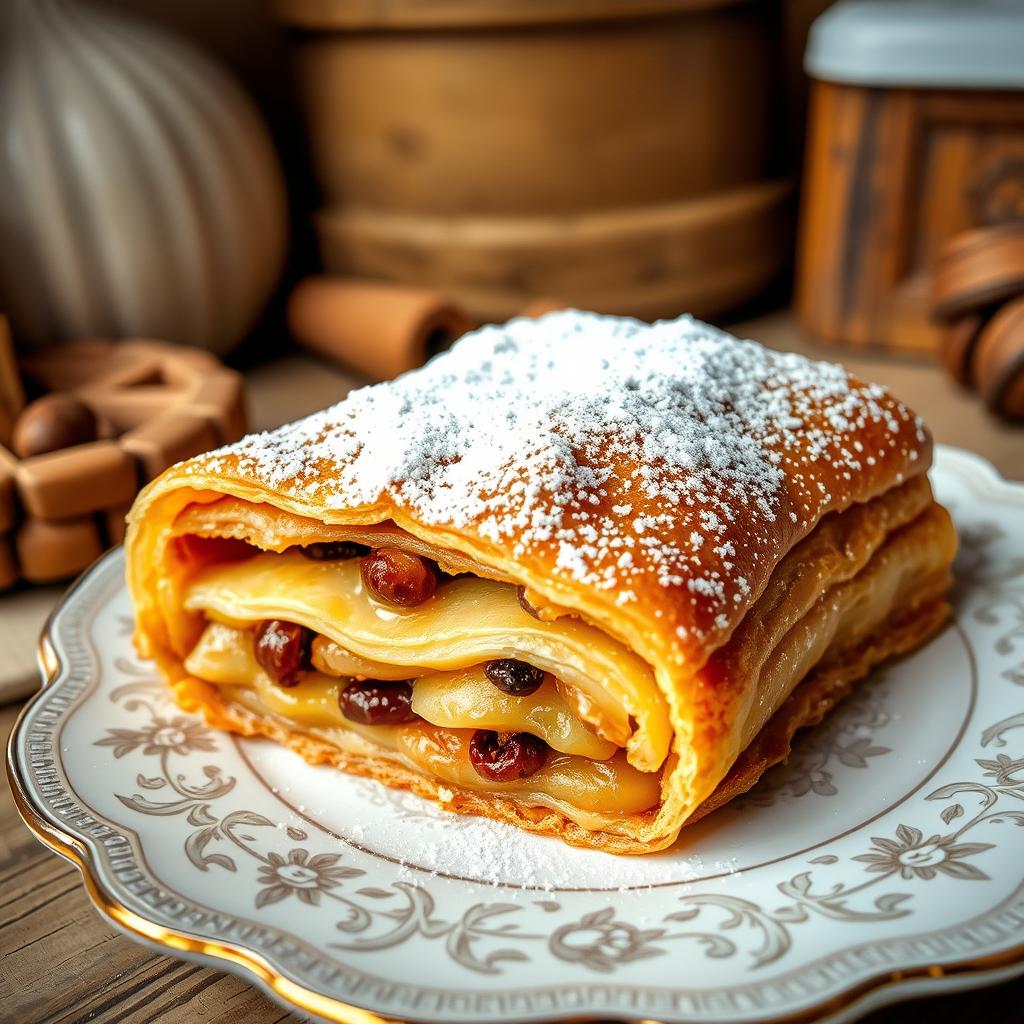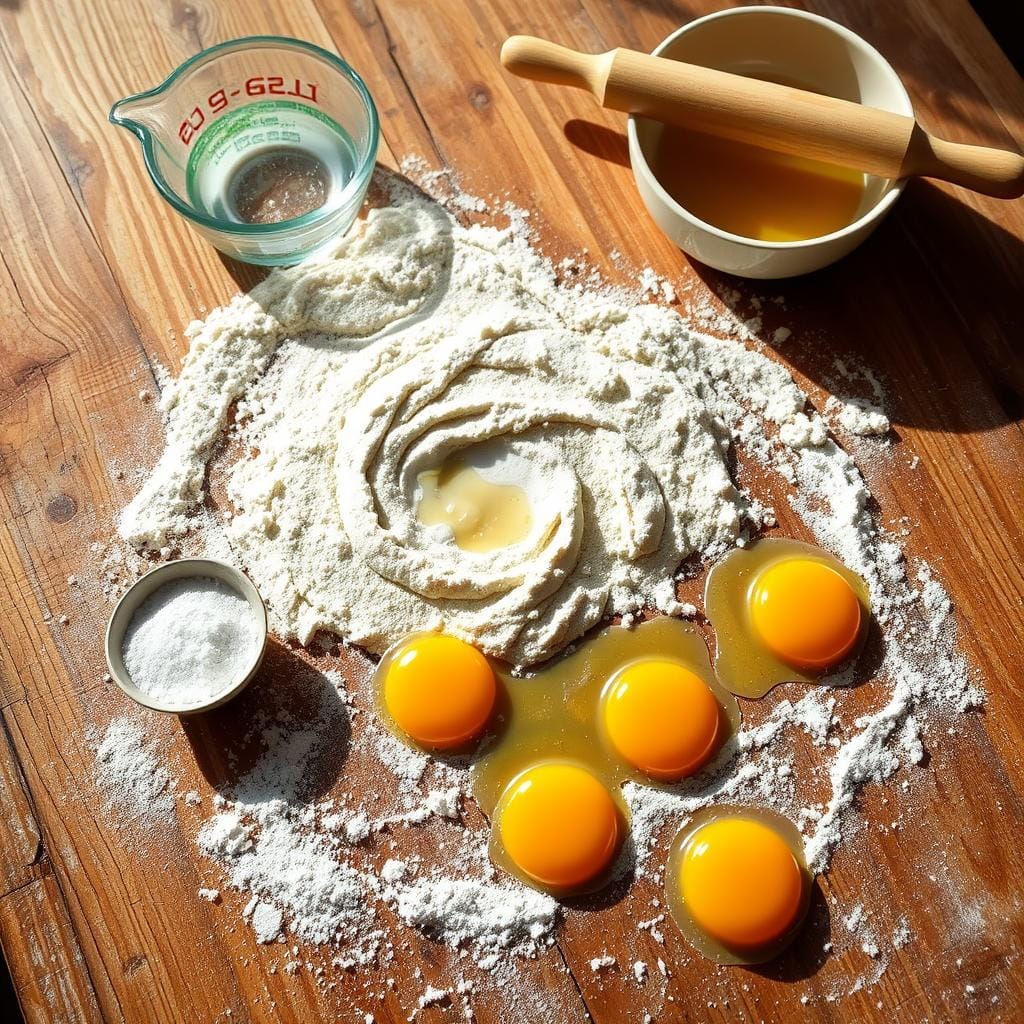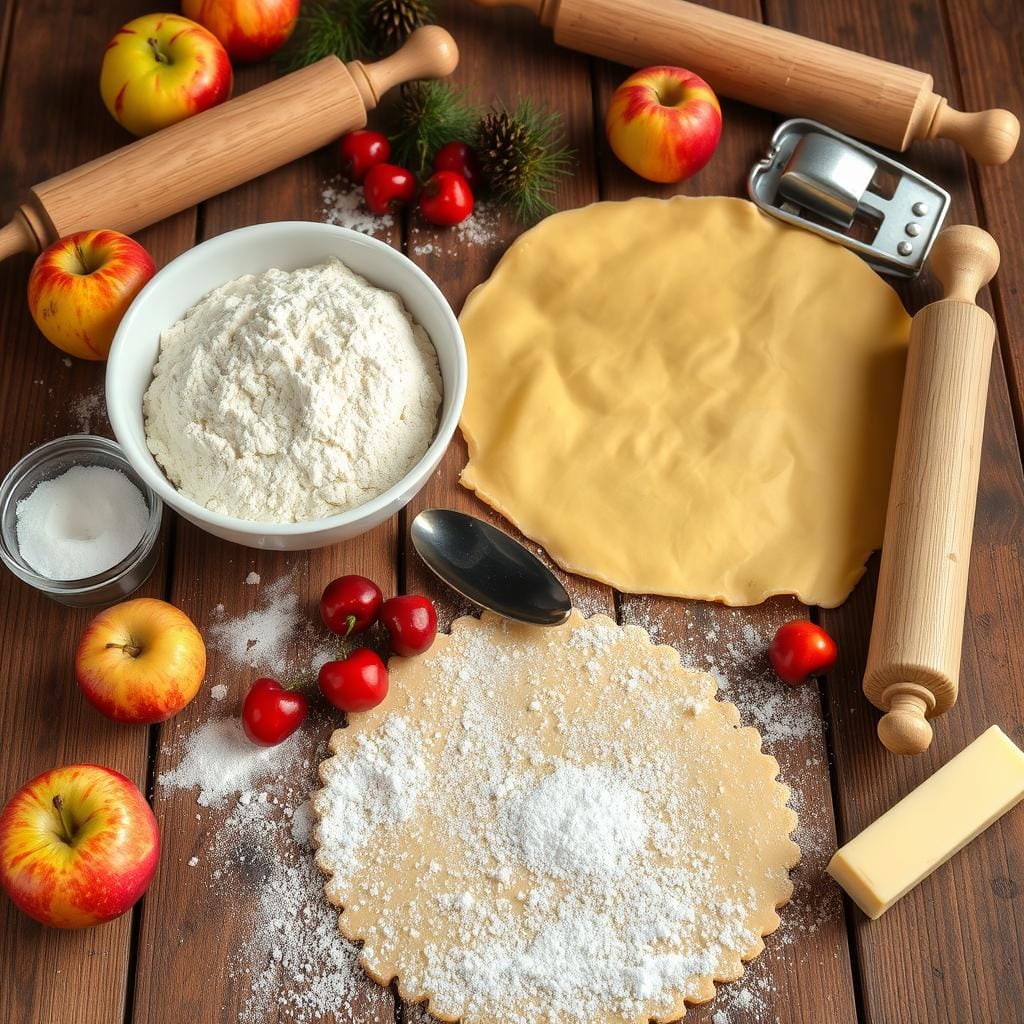What are strudels made of? The aroma of warm, buttery pastry fills the air, with crisp layers that reveal a mix of delicious flavors. This is the magic of strudel, bringing back memories of mornings in my grandmother’s kitchen, surrounded by family and tradition.
This guide will explore the ingredients and techniques of strudel. It’s for both seasoned bakers and those new to pastries. We’ll dive into the history and secrets of making this European delicacy.

Key Takeaways
- Strudels are a traditional European pastry with a rich history and cultural significance.
- The essential components of strudel include the delicate phyllo dough and a variety of sweet or savory fillings.
- Mastering the art of working with phyllo sheets and achieving the perfect layering technique is crucial for authentic strudel making.
- Classic fruit fillings like apple and berry are popular, but strudels can also feature a range of nut, spice, and even savory ingredients.
- Proper use of butter and oils, as well as understanding baking tools and equipment, are important for achieving the perfect strudel texture and flavor.
The History and Origins of Traditional Strudel
Strudel, the iconic layered pastry, has a rich history. It comes from the heart of Austrian cuisine. Over centuries, it has changed, adapting to local tastes while staying a favorite.
Austrian Roots and European Heritage
The story of strudel begins in the Austro-Hungarian Empire in the 18th century. It was inspired by Mediterranean and Middle Eastern dishes. But in Austria, strudel became a true classic.
Evolution Through Centuries
As Austrian cuisine spread across Europe, strudel changed. Each region added its own twist. Now, you can find apple, cheese, or spinach strudels in many places.

“Strudel is more than just a pastry; it’s a culinary tradition that has endured for generations, connecting people and cultures across Europe.”
Today, strudel remains a beloved part of Austrian cuisine and European food heritage. It shows the lasting charm of this timeless treat.
Essential Components of Authentic Strudel Dough
Making the perfect strudel dough is key to this beloved pastry. At its core, a few important ingredients come together. These ingredients make the crust flaky and delicate. Knowing their roles is vital for bakers aiming to excel in strudel making.
The main pastry dough for strudel includes flour, water, oil, and salt. Flour, often high-gluten, gives the dough its structure and chewiness. Water helps the dough come together, while oil adds richness and softness.
To get the flaky crust of strudel, the dough needs careful kneading and stretching. This aligns the gluten strands, creating layers. Finding the right balance in kneading is key to avoid a tough or too-soft crust.
| Key Ingredient | Function |
|---|---|
| Flour | Provides structure and chewiness |
| Water | Hydrates the dough, allowing gluten development |
| Oil | Adds richness and tenderness to the crust |
| Salt | Enhances the overall flavor |
By mastering the pastry dough and flaky crust aspects, bakers can truly capture the essence of strudel. They can make pastries that are a joy to eat.
“The perfect strudel dough is the foundation for a truly exceptional pastry.”

Understanding Phyllo Sheets: The Foundation of Strudel Making
At the heart of authentic strudel lies the delicate phyllo sheets. These sheets are the foundation that elevates this iconic layered pastry. Mastering the art of working with phyllo dough is crucial to achieving the sought-after flaky crust.
Working with Phyllo Dough
Phyllo dough, also known as filo, is a paper-thin sheet of unleavened pastry. It requires a delicate touch. To ensure success, handle the sheets with care, keeping them covered to prevent drying out.
Lightly brush each layer with melted butter or oil. This promotes the desired flakiness.
Tips for Perfect Layering
- Overlap the phyllo sheets slightly to create a seamless, even base for your strudel.
- Brush each layer with butter or oil before adding the next sheet, ensuring proper adhesion.
- Gently fold the overhanging phyllo over the filling to create a tidy, professional-looking roll.
Common Mistakes to Avoid
- Letting the phyllo sheets dry out: Keep them covered with a damp cloth or paper towel to maintain pliability.
- Tearing the delicate dough: Handle the sheets with care, using a gentle touch to transfer and layer them.
- Overstuffing the strudel: Resist the temptation to overload the filling, as this can compromise the flaky crust.
By mastering the techniques for working with phyllo sheets, you’ll unlock the secrets to crafting a strudel. This strudel will have a layered pastry that is both visually stunning and delightfully crisp.
What Are Strudels Made Of?
Strudels are a beloved pastry that many love. They are made from a mix of ingredients. The dough is the base, crafted for flakiness and elasticity. The dough used is phyllo dough, a thin, paper-like pastry.
The fillings are where strudels truly shine. You can find everything from classic apple strudel to berry and stone fruit options. These fillings are made with care, often including nuts, spices, and a bit of sweetness.
| Common Strudel Fillings | Ingredients |
|---|---|
| Apple Strudel | Apples, sugar, cinnamon, raisins, breadcrumbs |
| Berry Strudel | Raspberries, blackberries, blueberries, sugar, lemon zest |
| Nut Strudel | Walnuts, almonds, hazelnuts, honey, cinnamon |
Strudels can also have savory fillings. You can find them filled with spinach, cheese, or even meat. This adds a new twist to the traditional sweet strudel.
“The secret to a perfect strudel lies in the balance of the dough and the filling. Each component must work in harmony to create a truly extraordinary pastry.”
Whether you love the classic apple strudel or want to try something new, understanding strudels is key. It’s all about the dough, fillings, and sometimes nuts and spices. With this knowledge, you can make your own strudels and enjoy them.
Classic Fruit Fillings and Their Preparation
The heart of a great strudel is its fruit filling. From apple strudel to berry and stone fruit, the right mix can turn a simple dessert into a masterpiece. Learn how to make fruit fillings that will wow your guests.
Apple Strudel Filling
Apple strudel is a beloved classic. The secret to a delicious filling is choosing the right apples. Mix tart Granny Smith with sweet Gala apples for the best taste. Slice the apples thin, then mix with sugar, cinnamon, and lemon juice for extra sweetness and aroma.
Berry and Stone Fruit Variations
Beyond apple strudel, there’s a world of fruit fillings. Berries like raspberries, blackberries, and blueberries add freshness and color. For a tangy twist, try cherries, plums, or apricots. Cook the fruit with sugar and cornstarch to make it smooth and perfect for the pastry.
| Fruit Filling | Recommended Combinations | Preparation Tips |
|---|---|---|
| Apple | Granny Smith, Gala, Fuji | Slice thinly, toss with sugar, cinnamon, lemon juice |
| Berry | Raspberries, blackberries, blueberries | Cook with sugar and cornstarch for a spreadable consistency |
| Stone Fruit | Cherries, plums, apricots | Gently cook with sugar and cornstarch for a cohesive filling |
Mastering fruit fillings can take your strudel to new heights. Try different fruits and methods to find the perfect mix. Your homemade strudel will be a true delight.
Nuts and Spices: Enhancing Your Strudel’s Flavor
Adding the right nuts and spices can make your homemade strudel truly special. These ingredients can turn a simple pastry into a culinary masterpiece. By mixing them just right, you’ll create a strudel that will impress everyone.
Nutty Perfection
Nuts are perfect for strudel, adding texture and flavor. Try using almonds, walnuts, or pecans for a crunchy bite. For a softer touch, hazelnuts or pistachios are great. Mix different nuts to find your favorite taste.
Spice it Up
Choosing the right spices can take your strudel to the next level. A little cinnamon, nutmeg, or cardamom can make fruit fillings sweeter. Ginger or clove adds a warm, aromatic flavor. Try different spice mixes to find the perfect match for your strudel.
| Nut Varieties | Spice Pairings |
|---|---|
| Almonds, Walnuts, Pecans | Cinnamon, Nutmeg, Cardamom |
| Hazelnuts, Pistachios | Ginger, Clove, Allspice |
By carefully adding nuts and spices to your strudel, you’ll create a flavor explosion. This will not only impress your guests but also improve your baking skills.
The Role of Butter and Oils in Strudel Making
Butter and oils are key in making a great strudel. They add flavor and help create the flaky crust that strudel is known for.
Brushing Techniques
Brushing butter or oil on the dough is crucial. It’s a skill that makes a big difference. You want a thin layer that doesn’t make the dough too greasy.
Using a pastry brush helps cover every part of the dough. This step keeps the dough moist and helps create flaky layers.
Butter Alternatives
- Some bakers use fats other than butter for a different taste.
- Olive oil adds a rich flavor and a bit of crunch to the crust.
- Coconut oil works well because it can handle high heat.
- Vegetable or canola oil is good if you want the filling’s taste to shine.
Choosing the right fat is up to you. Try different fats and brushing methods to find what works best for your strudel.
Sweet vs. Savory Strudel Variations
Strudels are more than just the classic apple-filled dessert. In Austrian cuisine, there’s a wide range of sweet and savory strudels. Each one is made to please different tastes and preferences.
The traditional sweet strudel is a favorite in Austria. It’s filled with fruits, nuts, and spices. These baked desserts often have apple, cherry, or berry fillings. The flaky, buttery phyllo dough makes the strudel’s texture unique.
Savory strudels are also a big part of Austrian cuisine. They have fillings like sautéed veggies, cheeses, meats, and seafood. These strudels can be a main dish or a tasty appetizer, showing how versatile this pastry is.
Whether you love the sweetness of apple strudel or the savory taste of cheese and spinach, strudels offer a culinary adventure. They celebrate the rich heritage and variety of Austrian cuisine.
“The beauty of strudels lies in their ability to capture both sweet and savory flavors, making them a beloved staple in the Austrian culinary landscape.”
Essential Tools and Equipment for Strudel Baking
Mastering strudel baking needs the right tools and equipment. You’ll need specialized pastry rollers and durable baking surfaces. These kitchen essentials are key to achieving perfect, restaurant-quality strudels. Let’s look at the must-have items for a better strudel-making experience.
Must-Have Kitchen Tools
A sturdy rolling pin is crucial for shaping the strudel dough. Choose a classic wooden or an adjustable model for precise control. Also, a sharp knife or pastry cutter is essential for clean cuts in your strudel rolls before baking.
Baking Surface Options
A large, non-stick baking sheet or jelly roll pan is ideal for strudel baking. For a professional look, consider a silicone baking mat or a well-seasoned baking stone. These can help get a crisp, golden-brown crust on your strudels. Choose a surface that can handle high baking temperatures.

